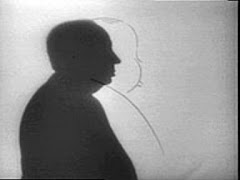(YouTube clip posted by siobhanalba)
In François Truffaut’s great 1973 film, some of the forms of 'agency within constraints' which comprise on-set film directing are clearly represented. We see (and hear) the call to ‘Cut! ('Coupez!’), actioned by the director Ferrand (played by Truffaut himself). We also watch Ferrand perform urgent gestures, in between takes, in his repeated attempts to get the actors (Alphonse, played by Jean-Pierre Léaud and Alexandre, played by Jean-Pierre Aumont) to do his bidding.
Film directing on set (like assistant directing on set, for that matter, too) is an activity thus shown to be largely comprised of performatives -- in other words, the doing of things with words (verbal utterances) and gestures (physical utterances), 'doings' which are executed in the hope of generating certain actions in others (with no automatic guarantee of success, it must be added); as well as of necessary (preceding or concurrent) reflexive processes (decision-making, etc.). In this sequence, individual directorial actions are shown in (unpredictable) interaction with the agency of those others who occupy different places in the on-set hierarchy.
What I love about the opening sequences of a number of films about film directing (see my previous posting on this topic), is that, as we can see in La Nuit américaine/Day for Night, there is often a hugely celebratory quality to the (re-)presentation of the processes of filmmaking. In this instance, the opening sequence of La Nuit américaine concludes with a virtuosic crane shot (repeated later in the film); our view of the plateau (film set) is dramatically pulled back and up, away from the organised bustle of the set, a move underscored by the equally soaring, or swelling, strains of the film's musical theme.
The scale of the visual spectacle in this sequence, together with the exuberance of its musical accompaniment, evoke for me notions of orchestration and, especially, conducting. The latter idea, in particular, resonates because of the presentation of Ferrand/Truffaut’s gestures as he verbally and physically directs (guides, orders) and conducts (leads) his actors and technicians. Because of the mode chosen here of the director's 'irruption' into the film (a jump cut from a long shot of the actors performing to a brief close up of Ferrand/Truffaut speaking), Ferrand (and Truffaut) is seen as a Little Big Man, compelled by his vision, and repeatedly, even frantically, trying to impose it throughout the various (fragments of) takes that we see, before, it seems, finally getting everything more or less together. The subsequent crane shot then leaves us with a harmonious and pleasurable image of cinema, produced under its usual ‘factory-like conditions’ (V.F. Perkins, Film as Film [London: Penguin, 1972], p. 158); the shot retrospectively imputes some calm, harmonious method to the evident, partial discord and madness of the whole process.
Alongside the depiction of the activities of a director, what is also graphically figured in the opening sequences of La Nuit américaine/Day for Night, then, are the huge constraints of the space within which the director’s activities take place. Here and in other films (another good example would be David Mamet's State and Main, 2000), this space (here, that specifically of the plateau) is clearly shown to be a ‘time-space’: a field of, and for, action which is constrained by time, by ambient conditions and practicalities, by multiple agencies, and by the need to co-ordinate/orchestrate the activities in this field, these circumstances, to get everything (or as much as humanly and technically possible) done in time.
(Some thoughts on the conceptualisation of the practice of film directing, which draw upon 'Film authorship studies and the concept of agency', a paper I gave at the Screen Studies Conference, University of Glasgow, on July 1, 2000).
© 2008 Catherine Grant






1 comment:
All you say may be true, but what stands out for me in the opening scene of LNA is an essay on onscreen/offscreen.
#
At one level he is playing with the notion how offscreen forms a significant part of a complex decoupage, but as soon as you show the off-creen in it entirety (using an even taller crane...) what clearly works onscreen and offscreen (imagined and previously seen), falls apart: the meaning of Truffaut's shot (he is saying) is within the frame even though this necessarily includes cleverly constructed offscreen elements.
#
He shows his shot first, then from what he has made it. It would not have worked the other way round.
Post a Comment